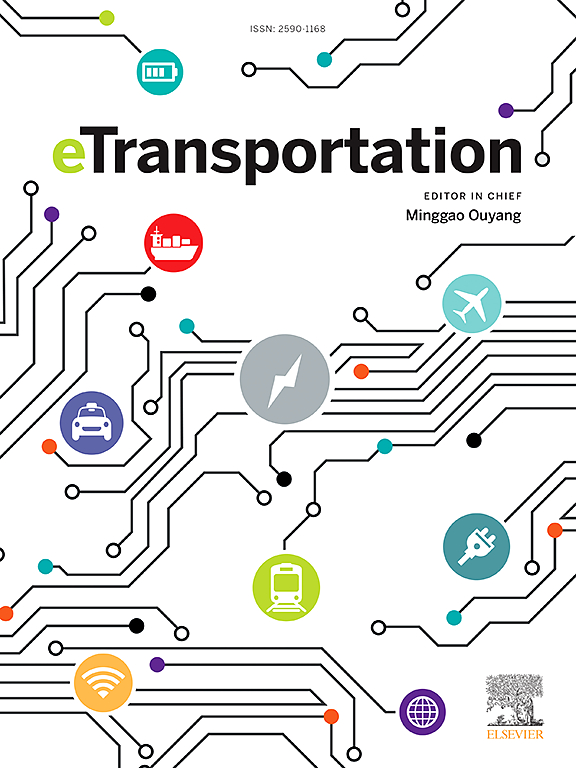Electrochemical–thermal correlation for assessing potential thermal runaway in automotive pouch cells via 3D numerical simulations
IF 17
1区 工程技术
Q1 ENERGY & FUELS
引用次数: 0
Abstract
Electrochemical and thermal deviations in lithium-ion batteries under harsh C-rate conditions can lead to spatial differences in thermal runaway risk, highlighting the need to understand temporal and spatial distributions of electrochemical–thermal characteristics. In this study, a comprehensive three-dimensional model is established for a 58.3 Ah commercial automotive pouch-type cell to investigate local electrochemical–thermal characteristics under such conditions. The model is rigorously validated by comparing simulation results with experimental voltage and temperature profiles, as well as spatially resolved data from IR-based temperature mapping and MFI-based current density measurements. Simulation results demonstrate that higher C-rates cause greater temperature rises—24.48 °C (1C), 54.88 °C (3C), and 81.08 °C (5C)—and larger local temperature deviations—0.65 °C (1C), 5.23 °C (3C), 13.25 °C (5C)—highlighting the significant thermal effects associated with higher C-rates. By correlating overpotential with heat generation, the analysis reveals the electrochemical origins of temperature rise and thermal inhomogeneity. Component-specific analysis shows that, as the C-rate increases, heat generation in the electrodes—particularly reaction and ionic ohmic heat in the positive electrode, which together account for 51.31 % of the total—becomes more prominent. Moreover, reversible heat significantly rises towards the end of discharge, reaching 59.23 W, comparable to reaction heat. Meanwhile, in-plane distribution analysis reveals that temperature deviations are driven by variations in electrical current density near the tab connections, resulting in localized increases in electronic ohmic heat. The electronic ohmic heat near the tab connections is approximately 2.37 times higher than average, highlighting significant localized thermal effects in these areas.

通过三维数值模拟评估汽车气囊电池潜在热失控的电化学-热相关性
在恶劣c倍率条件下,锂离子电池的电化学和热偏差会导致热失控风险的空间差异,这凸显了了解电化学-热特性的时空分布的必要性。在本研究中,建立了58.3 Ah商用汽车袋式电池的综合三维模型,研究了该条件下的局部电化学-热特性。通过将仿真结果与实验电压和温度曲线,以及基于红外的温度映射和基于mfi的电流密度测量的空间分辨数据进行比较,对该模型进行了严格验证。模拟结果表明,较高的碳速率导致更大的温度上升- 24.48°C (1C), 54.88°C (3C)和81.08°C (5C) -以及更大的局部温度偏差- 0.65°C (1C), 5.23°C (3C), 13.25°C (5C) -突出了与较高的碳速率相关的显著热效应。通过将过电位与热的产生联系起来,分析了温升和热不均匀性的电化学根源。组分特异性分析表明,随着c率的增加,电极产生的热量,特别是正极的反应热和离子欧姆热,占总热量的51.31%,变得更加突出。此外,在放电结束时,可逆热显著上升,达到59.23 W,与反应热相当。同时,平面内分布分析表明,温度偏差是由卡片连接附近电流密度的变化驱动的,导致局部电子欧姆热增加。卡箍连接处的电子欧姆热约为平均值的2.37倍,突出了这些区域的显著局部热效应。
本文章由计算机程序翻译,如有差异,请以英文原文为准。
求助全文
约1分钟内获得全文
求助全文
来源期刊

Etransportation
Engineering-Automotive Engineering
CiteScore
19.80
自引率
12.60%
发文量
57
审稿时长
39 days
期刊介绍:
eTransportation is a scholarly journal that aims to advance knowledge in the field of electric transportation. It focuses on all modes of transportation that utilize electricity as their primary source of energy, including electric vehicles, trains, ships, and aircraft. The journal covers all stages of research, development, and testing of new technologies, systems, and devices related to electrical transportation.
The journal welcomes the use of simulation and analysis tools at the system, transport, or device level. Its primary emphasis is on the study of the electrical and electronic aspects of transportation systems. However, it also considers research on mechanical parts or subsystems of vehicles if there is a clear interaction with electrical or electronic equipment.
Please note that this journal excludes other aspects such as sociological, political, regulatory, or environmental factors from its scope.
 求助内容:
求助内容: 应助结果提醒方式:
应助结果提醒方式:


